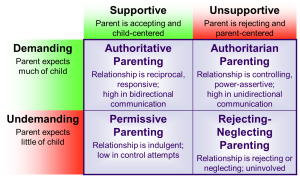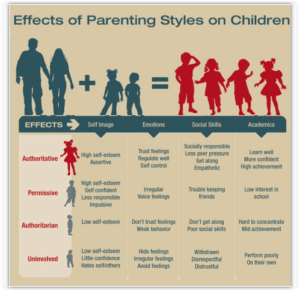7
ENGAGING FAMILIES
Learning Objectives
After completing the readings and activities in this chapter you should be able to:
Introduction
As you read and explore the resources in the chapter, consider the ways family or parenting styles might impact development. Do you remember learning about parenting styles in your Child Development course? The chart below may assist you in recalling the information. The first part of the chapter will look at how parenting styles impact an infant and toddler’s development.

The second part of the chapter will explain the importance of family engagement.
Parenting Styles
Research indicated that parenting style, including parent-child interaction, parent-child joint activities, parents’ involvement in children’s education are significant to the socialization and functioning patterns of the child (Talib, Mohamad, & Mamat, 2011[1]). For example, a families working conditions will impact child development. Professional families typically have more complex work schedules and tasks while families employed in factories or stores have more fixed schedules and tasks. Talib, Mohamad, and Mamat (2011) suggest that the type of parental work can result in values that get passed down and enforced to their children. Professional workers often value self-direction: freedom, individuality, creativity, where members of the working class may value conformity: orderliness, neatness, and obedience.
Talib, Mohamad, and Mamat (2011) also describe how parenting styles impact development. For example, parents who use an unsupportive and undemanding uninvolved pattern of parenting can influence children to have outbursts and be combative. While undemanding and supportive or indulgent parents may leave the child confused, needing guidance and role models and unsure of a direction in life. Everything a parent does can influence their child in a positive or negative way. See the chart below for a summary of the impact of parenting on development.

What is a typical family?
“Pretty much everyone agrees that the era of the nuclear family, with a dad who went to work and the mom who stayed at home, has declined to the point of no return,” asserts Belinda Luscombe in a Time magazine article. “The big question is: What is replacing it? Now a new study suggests that nothing is — or rather, that a whole grab bag of family arrangements are. More Americans are in families in which both parents work outside the home than in any other sort, but even so, that’s still only about a third.”
Luscombe describes the work of University of Maryland sociologist Philip Cohen, the author of The Family: Diversity, Inequality, and Social Change. Cohen identifies the three biggest changes in family life in the past 50 years are the:
- Decline of marriage (in 2010, 45% of households were headed by a married couple, whereas in 1960 it was close to 66%) increasing people living alone and in unrelated people living together
- Rise of the number of women in the paid workforce
- Multitude of family structures such as: blended, remarried and co-habiting families. Families headed by single moms‚ whether divorced, widowed or never married, are now almost as numerous as families that have a stay-at-home mom and a breadwinner dad — about 22% and 23%, respectively.
Source: “There is No Longer Any Such Thing as a Typical Family,” by Belinda Luscombe, Time, September 3, 2014.
Family Engagement
Research suggests that meaningful engagement of families in their children’s early learning supports school readiness and later academic success (Henrich & Gadaire, 2008[2]; Weiss[3], Caspe, & Lopez, 2006). As a means to supporting family engagement and children’s learning, it is crucial that programs implement strategies for developing partnerships with families (Henderson & Mapp, 2002[4]). The first reading Family Involvement Makes a Difference: Family Involvement in Early Childhood Education. from the Harvard Family Research Project reports on the research and provides many research based strategies for you to consider in your work with children and families.
Family engagement occurs when there is an on-going, reciprocal, strengths-based partnership between families and their children’s early childhood education programs. The second reading is a position statement from the Division for Early Childhood. The position statement defines responsive behavior. The National Association for the Education of Young Children NAEYC created a comprehensive definition of family engagement that features six factors:
- Families should act as advocates for their children and early childhood education program by actively taking part in decision making opportunities.
- Consistent, two-way communication is facilitated through multiple forms and is responsive to the linguistic preference of the family.
- Families and early childhood education programs collaborate and exchange knowledge.
- Early childhood education programs and families place an emphasis on sustaining learning activities at home and in the community.
- Programs and families collaborate in establishing goals for children both at home and at school.
- Early childhood education programs create an ongoing and comprehensive system for promoting family engagement.
The third reading by Gonzalez-Mena[5] illustrates responsive family engagement with several examples. How will you suspend judgment long enough to try to understand a different perspective that families may have? How will you respond if the differences are harmful to children? How far can childrearing practices be respected while at the same time ensuring children’s rights are protected?
Read and Participate
After reading Chapters 5, 6, and 7 about the influences of health and socio-economic circumstances, as well as engaging families. Use the reflection form below as you complete the readings and/or watch the videos as a note taking method. Using your notes as recorded on the table, write out 3 paragraphs to summarize your ideas. Share your connections, extensions, and curiosities either in the Blackboard discussion or during a class discussion.
Reading Reflection Form
| CRITERIA | NOTES | EXAMPLES FROM WEEKLY CONTENT |
|---|---|---|
| Connections
Relate ideas from the reading to learning in other courses or life experience. |
||
| Implementation
What strategies or methods have you used in the past, or will use in the future to support what you have learned from the weekly content? |
||
| Curiosities
What are you still curious about? What do you want to explore further? Why? |
||
| Additional Online Resource(s) to Share
|
- Talib, J., Mohamad, Z., & Mamat, M. (2011, May). Effects of Parenting Style on Children Development. World Journal of Social Sciences, 1(2), 14-35. ↵
- Henrich, C. & Gadaire, D. (2008). Head Start and parental involvement. Infants and Young Children, Vol. 21 (1), pp. 56-69. ↵
- Weiss, H. B., Caspe, M., & Lopez, M. E. (2006). Family involvement in early childhood education. Cambridge, MA: Harvard Family Research Project. ↵
- Henderson, A. T., & Mapp, K. L. (2002). A new wave of evidence: The impact of school, family, and community connections on student achievement. Austin, TX: National Center for Family & Community Connections with Schools Southwest Educational Development Laboratory. ↵
- Gonzalez-Mena, J. (2010). Cultural responsiveness and routines: When center and home don't match. Exchange (19460406), (194), 42-44. ↵
- Gillespie, L. G. (2006, September). Cultivating Good Relationships with Families Can Make Hard Times Easier! Young Children, 53-55 ↵
